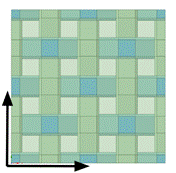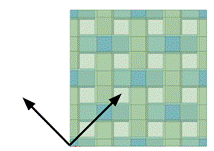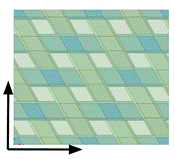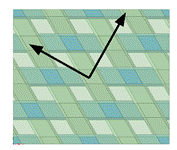For woven composites, the fabric fiber angle is computed as an additional property.
Unsheared woven composites have, correctly, an orthotropic material behavior in the coordinate system aligned with the yarns (0°/90° coordinate system).

Note that there is a second coordinate system in which the woven material is orthotropic (the one where the bisectors are the coordinate axes):

However, as soon as there is some shear due to draping, then the material is only orthotropic with respect to the bisector coordinate system:
|

Material is not orthotropic with respect to this coordinate system. |

Material is orthotropic with respect to this coordinate system. |
Because is not natural for the engineer to work with the bisector coordinate system, we provide the fabric fiber angle as an additional property that allows you to transform between the two coordinate systems.
(Note that the orthotropy of the woven material with respect to the bisectors holds true only for balanced weaves, that is, when weft and warp yarns are identical.)
The fabric fiber angle is the angle between the material 1 direction (the first principal axis of orthotropy) and the (draped) fiber direction.

Illustration of the fabric fiber angle:
black: material coordinate system
green: (draped) fiber direction
red: fabric fiber angle (negative in this case)
If the flag Align Yarn With X Direction is activated for the woven composite creation, then the fabric fiber angle is zero. Furthermore, the material 1 direction and the fiber direction agree, but note that the material is in general not orthotropic with respect to this coordinate system.
This would have a negative effect on the results for sheared woven composites and therefore, we do not recommend this option for non-zero shear.
If the flag Align Yarn With X Direction is deactivated for the woven composite creation, then the fabric fiber angle is non-zero and the material properties are computed in the bisector coordinate system.
If you use this material afterwards in ACP, you can nevertheless still work with the fiber directions. ACP will compute the material 1 direction based on the fiber direction and on the fabric fiber angle and set the section data accordingly.


